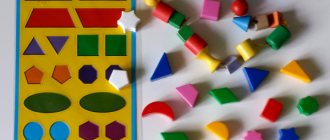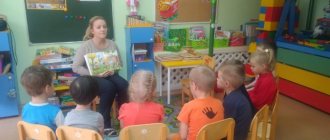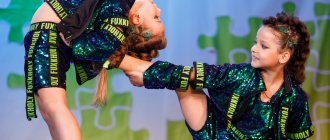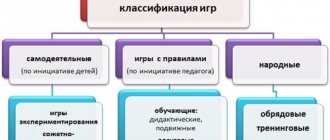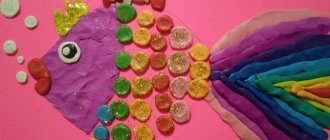MAGAZINE Preschooler.RF
PROGRAM for the artistic and aesthetic development of children through the means of fine arts in preschool educational institutions (in accordance with the Federal State Educational Standard)The program was compiled by: art teacher: Salimova V.A. methodologist: Lozko V.Yu. Khanty-Mansiysk
“In children’s creativity (with proper guidance) the child’s self-expression and self-affirmation occurs, his individuality is clearly revealed” (V. A. Sukhomlinsky)
I. EXPLANATORY NOTE
Relevance. Drawing is one of the most important means of understanding the world and developing knowledge of aesthetic education, since it is associated with the independent practical and creative activity of the child. In the process of drawing, a child’s observation and aesthetic perception, artistic taste and creative abilities are improved. By drawing, the child forms and develops certain abilities: visual assessment of shape, orientation in space, sense of color. Special skills and abilities are also developed: eye-hand coordination, hand control.
Systematic mastery of all necessary means and methods of activity provides children with the joy of creativity and their all-round development (aesthetic, intellectual, moral-labor, physical). And also, it allows you to fruitfully solve the problems of preparing children for school.
The works of domestic and foreign specialists indicate that artistic and creative activity performs a therapeutic function, distracting children from sad, distressing events, grievances, relieving nervous tension and fears. Causes a joyful, upbeat mood and ensures a positive emotional state for every child.
The content of the educational field “Artistic Creativity” is aimed at achieving the goals of developing interest in the aesthetic side of the surrounding reality, satisfying children’s need for self-expression through solving the following tasks:
- development of children's productive activities (drawing, modeling, appliqué, artistic work);
- development of children's creativity;
- introduction to the fine arts.
This program is based on an understanding of the priority of educational work aimed at developing perseverance, accuracy, patience, the ability to concentrate, fine motor skills and coordination of hand movements in children.
Novelty. For a long time, the main task of the circle was to teach children fine arts skills using traditional and non-traditional drawing techniques. But work practice shows that the full artistic and aesthetic development of a child is impossible without his moral education. Personality, like an artistic image, represents the unity of form and content in their interdependence.
The moral qualities of preschoolers are actively developing through exposure to art, music, literature, and folk culture. The integration of aesthetic feelings and moral experiences creates the basis for understanding the value of everything created by nature and man.
In each section of the program, the line of development of social and aesthetic feelings becomes an obligatory component of the education and development of preschool children.
Also, a distinctive feature of this program is the development of the communicative abilities of preschoolers based on their own creative activity.
The program was developed in accordance with the current Federal State Educational Standard and is an innovative educational program document.
This program develops in children the creative abilities they need for subsequent training in fine arts at school.
Type of program: compiled - compiled on the basis of various developments and collections:
- I.A. Lykova “Colored palms” ;
- T. S. Komarova “Classes in visual arts in kindergarten” ;
- T. G. Kazakova “Classes with preschoolers in visual arts” ;
- T. N. Doronova “Visual activity and aesthetic development of children from 4 to 5 years old” ;
- A. S. Galanov, S. N. Kornilova, S. L. Kulikova “Classes with preschoolers in fine arts” ;
- T. A. Danilina, V. Ya. Zedgenidze, N. M. Stepina “In the world of children's emotions” and others.
The program has complete methodological support, demonstration and handout material, contains methodological recommendations, lesson notes for all ages.
Purpose of the program: Development of creative and mental abilities, cognitive activity through visual arts classes.
Pedagogical tasks:
Educational
- To form in preschoolers initial knowledge about visual creativity.
- To familiarize yourself with the basic concepts of artistic activity, means of expression and methods of depiction.
- To instill skills in working with pencils, paints, paper, plasticine and other materials, based on studying the laws of realistic depiction, in a form accessible to children.
- Introduce children to non-traditional techniques.
Developmental
- To promote the development of visual abilities through educating children in the ability to observe, see the features of surrounding objects, compare them with each other, find common and different features in them, and highlight the main thing.
- Develop cognitive processes of aesthetic perception: figurative and spatial thinking, imagination, attention, memory.
- Develop the child’s creative abilities: taste, sense of color, compositional solutions, artistic choice.
- Develop fine muscles of the fingers and motor functions of the hands.
- Promote the development of sensorimotor skills.
- Promote the development of coordination in the work of the eyes and hands, develop coordination of movements, accuracy of actions.
- Develop communication skills.
Educational
- To cultivate in children moral and volitional qualities: the need to complete a task, to study with concentration and purpose (perseverance), to overcome difficulties; accuracy of work.
- Nurture and develop skills in interpersonal relationships with peers - establishing friendly contacts, the desire to help each other, goodwill.
- Cultivate trusting and open relationships with adults, recognition of their authority, expectation of help and support.
- Foster a caring attitude towards your own work and the work of your comrades, art supplies and objects around the group.
Health-saving
1. Teach health-saving technologies: preservation of vision, proper posture during work.
Program sections:
Basics of artistic representation
Modeling
Artistic work
Age of children participating in the implementation of the work program: children from 2 to 7 years old (2-year-old - preparatory group).
Implementation period: 4th year of study.
Forms of organization of the educational process:
- OOD (organized educational activities)
- Activities of the Fine Arts Club “Magic Fingers”
- Individual work (when performing complex work)
- Inviting DPI masters to visit
- Visiting museums and children's exhibitions
- Participation in exhibitions and competitions
Organization of educational activities in groups according to the main program:
Age of children: second junior group, middle group, senior group, preparatory group
Period: 4 years.
Classes are held: 1 OOD lesson per week (based on 36 calendar weeks in the academic year)
Duration of one lesson: in the early development group – 8-10 minutes.
in older groups – 10-15 minutes
in younger groups – 15-20 minutes
in older groups – 20-25 minutes
| Next > |
Comparative analysis of programs for artistic and aesthetic development
master the sequence of work: lay out the forms, see if they look nice, then take the forms one by one, spread glue on the oilcloth and carefully put them in the same place, pressing them with a napkin;
encourage children to use tools carefully;
introduce children to the possibilities of using non-figurative materials: crushed shells, sawdust, cotton wool, pieces of torn and crumpled paper [18].
The authors of the educational program “Rainbow” T.I. Grizik, T.N. Doronova, E.V. Solovyova, S.G. Yakobson set the following tasks in the application:
learn to convey your feelings and relationships using various visual and artistic means;
instill interest in work and teach how to finish what you start;
teach accuracy in performing work [54].
Thus, in the educational programs considered, the authors direct the teacher to build a rich and diverse process of forms of artistic and aesthetic concepts. An integral part of these programs is education through the means of nature and art, which ensure the integrity and harmony of personal development, creating the prerequisites for expanding and deepening knowledge of the world.
Particular attention is paid to familiarizing children with various methods of examining the shape, color, size and other characteristics of objects, and the use of sensory standards (circle, square, triangle).
The child is able not only to combine objects by external similarity (shape, color, size), but also to assimilate generally accepted ideas about groups of objects (clothing, dishes, toys).
In the partial program “Colored Palms” (I.A. Lykova), the artistic, aesthetic and sensory development of children is presented as follows.
The purpose of this program is the following, to form in children of early and preschool age an aesthetic attitude towards artistic and creative abilities in visual activity [36, p.4].
The initial principles for constructing pedagogical technologies that implement this program are presented as follows:
from sensorimotor, fragmentary perception to holistic, sequential viewing and examination;
from the perception of external random features as elements of expressiveness to the awareness of their internal connections, understanding of the appropriateness and unity of the expressive means of the artistic image;
from unmotivated assessments based on individual, minor properties, to an adequate motivated analysis of essential aesthetic qualities;
from short-term and unstable emotional reactions to individual bright objects to a stable aesthetic feeling for works of folk art;
Programs of artistic and aesthetic education in preschool education. - presentation
Artistic and aesthetic education programs in preschool education

Education transforms development into a directed and controlled process, according to L.S. Vygotsky’s meaning of aesthetic education is to “lead development.”
Artistic and aesthetic education is the process and result of the formation and deepening of the abilities of visual and emotional perception of the beauty of the external world, the sphere of art, as well as the development of independent creative activity in the world of beauty. The program for preschool children includes several stages: 3–4 years, a positive emotional reaction to the image of recognizing familiar or valuable objects in the child’s understanding in the picture. The psycho-emotional level of development, as well as the degree of development of abstract thinking and imagination, does not yet allow us to talk about the perception of an artistic image. Evaluative motivation is simple, everyday, subjective in nature, for example, I chose this photo because it shows a toy, and I like it. At the age of 5, a child not only pays attention, but also begins to consciously perceive the attractive aesthetic qualities of a work of art. Children at this age are able to experience feelings of emotional satisfaction when contemplating the color palette of a painting; less often they will react to the compositional solution and features of the form. At 6–7 years old, pupils are able to overcome the limitations of literal perception of external obvious signs of depicted objects. The level of development of figurative thinking makes it possible to capture the subtle internal characteristics of the depicted artistic objects.
Conditions that stimulate the child’s transition to a new qualitative level of artistic and aesthetic development: - competent arrangement of the material and cultural spatial environment, it should include objects that are attractive for contemplation and study; -high level of professional competence and personal qualities of the teaching staff providing aesthetic education of children; - interest and attention to the child’s creative experiments, the desire to notice and hear his thoughts and experiences; -thought-out, purposeful pedagogical activities to organize the aesthetic perception of students.
The purpose of such education in pedagogical definition is 1. Formation and improvement of aesthetic taste, nurturing a sense of beauty. 2. Formation and development in the child’s personality of the ability to love and appreciate the beauty of the world around him, to enjoy the contemplation of beauty in the field of art and in everyday life. 3. Developing a deep understanding and competent assessment of art objects. 4. Actualization of the creative abilities of the individual and their embodiment in active independent creative activity to create beauty in life. 5. Formation of moral and ethical universal norms and values, achievement of a high level of general erudition, expansion of the sphere of aesthetic interests. 6. Conscious creative work contributes to the development of a culture of thinking and speech, strong-willed personality traits, self-organization skills, internal control and discipline.
Objectives and principles The objectives of artistic and aesthetic development are specified in accordance with the characteristics of the developmental psychology of children and are divided into four groups: Development of the emotional sphere of aesthetic feelings, personal priorities and interests; formation of one’s own collection of artistic images, thanks to which the inner life of the child’s personality will become rich and meaningful. Knowledge and judgment is the accumulation of a basic arsenal of aesthetic knowledge and internal personal experience of sensory experiences, without which it is impossible to awaken a living personal interest in the world of aesthetic phenomena. To achieve this task, students are introduced into the world of standards of sensory perception, beauty, aesthetic categories, emotional behavior, etc. Formation, on the basis of acquired knowledge and experience, of socio-psychological qualities of the individual, allowing them to experience a feeling of emotional satisfaction from the perception of aesthetic objects and phenomena. At the same time, it is necessary to develop in the child the ability to analyze, critically and reasonably evaluate any work. Education and development of abilities for creative activity in the field of art, manifestation and improvement of artistic, musical, plastic aspects of creative inclinations.
Principles of pedagogical work on artistic and aesthetic development Individual approach based on respect and attention to the psychological and intellectual characteristics of students. Creating individual conditions for development involves developing an optimal trajectory of a pedagogical strategy for each child, taking into account his natural abilities and inclinations. The unity of the educational and educational process. This principle is of a fundamental developmental nature and ensures the integrity of the ethical, aesthetic and intellectual development of the child’s personality. The deep internal connection of children's creativity with real life determines the diversity of content, techniques and methods of organizing and implementing artistic practice. Integration of various types of art contributes to a deeper and more holistic knowledge and understanding of phenomena and objects of the surrounding world, versatile perception and harmonious embodiment of children's imagination and fantasy in the child's musical, speech, theatrical and visual activities. The principle of nationality and cultural conformity helps preschoolers understand the deep genetic connections between the cultural picture of the world and the traditional self-awareness of the people. In addition, it broadens their horizons, enriches the inner world of students with new cognitive facts from the life of other countries and continents, and instills skills of respect for the uniqueness and originality of life and artistic creativity of other peoples. Continuity in artistic and aesthetic education and upbringing of preschoolers and younger schoolchildren.
Types and forms Types of artistic and aesthetic development: Aesthetic communication will awaken curiosity in children, help them believe in themselves and feel the taste of creative activity, in addition, develop interest in self-knowledge, prepare them to understand the meaning of their existence. Communication on topics of the sublime and beautiful will show in the child a desire to bring goodness and beauty to the world, to give love and light to the people around him. Contact with nature will form a culture of friendly style of relationship with the natural world, will help to more subtly feel and understand the richness and uniqueness of the surrounding world, and will sow the seeds of sensitivity in the child’s soul. Independent activity (music, poetry, drawing, theater, crafts) - theoretical and practical immersion in the world of art will teach you to appreciate and understand it, experience aesthetic pleasure from communicating with various types and genres of art, and form artistic ideas and guidelines. Organization of the subject-spatial environment, aesthetically attractive things and objects form taste, create mood and atmosphere, stimulate the artistic and aesthetic performance of children. Holding holidays and organizing games is the embodiment of an aesthetic idea in an integrated fusion of music, words, decorations and plastic arts. The holiday allows you to combine the aesthetic and intellectual spheres of development and enhance the emotional effect of artistic influence. The joy of hand-made creative work in the garden or flowerbed. Sports games, formation of physical culture of the body.
Forms of organization of aesthetic development: Play activity is a means of integrating the child’s creative activity with all types of art. Training sessions: drawing, music, design, modeling, appliqué. An exhibition of children's works allows us to demonstrate dynamics and also monitors the results of educational work. Excursions - organization of observation and study of various objects in natural conditions or in museums. Holidays: children's concerts, competitions, theatrical thematic and literary performances and evenings, entertainment games, surprise walks, musical fairy tales.
Planning How planning is carried out The project of pedagogical activity is a necessary condition for the implementation of a scientifically based, orderly, consistent and controlled organization of the educational process with the specification of the necessary program tasks, methods and means. When planning, not only the teacher’s understanding of the characteristics of developmental psychology, but also taking into account the child’s personal capabilities and abilities is of enormous importance. The developmental concept of an educational strategy will require the teacher to: - study the personal characteristics of the character, worldview, inclinations, and social conditions of the child’s life; — the ability to assess the level of maturity of personal qualities; — understanding the psychological motivation of behavior, knowledge of the students’ areas of interest; - skillful stimulation of activity, initiative, self-organization of the child’s activities; - timely diagnosis and elimination of problems that impede the achievement of educational goals.
Planning tasks: - understanding the prospects of activity; — uniform distribution of educational material taking into account a specific period of time; -preparation of necessary forms of work, development of pedagogical methods and techniques.
The calendar plan is developed for a short period of time (1-2 lessons) and includes: a content part indicating program goals; formulation of educational objectives; indication of methodological techniques; list of necessary teaching aids. Long-term plan - strategic distribution of the educational process over a long period of time (from 1 month to 1 year). The plan is based on a program document, which indicates the amount of knowledge, skills and abilities for each age category.
Introduction to the field of art Junior group - Examination and discussion of artists' illustrations for literary works, learning the skills of formulating answers to adult questions about plot pictures. It is important to introduce children to traditional folk toys, to focus children’s attention on the character traits of the folk hero and the decorative style of its design. - Activating children's attention and interest in the various contours and lines of the drawing. The teacher helps to master the depiction of simple objects of different shapes, straight intersecting lines, and simple compositions. -It is necessary to teach the child to comprehend and discuss a self-drawn image, to awaken in the child a feeling of emotional pleasure and joy from communicating with the world of colors and shapes. — Training in careful and proper handling of artistic material. The teacher’s task is to teach the child to hold a pencil freely with three fingers, carefully pick up paint on the brush, and remove excess paint from the bristles of the brush on the edge of a jar of water.
Senior group Children are introduced to the professions of artist, composer, writer, actor, as well as art genres such as painting, music, architecture, literature, circus, theater. Pupils learn to recognize natural phenomena and surrounding objects in artistic images of literary works, fairy tales, and musical compositions. The drawing becomes more complex, children are taught to mix paints, paint, rhythmically drawing lines in one direction, without going beyond the contours. Skills are developed in proportionally placing parts of an image, taking into account size and shape.
Preparatory group The child masters the skill of drawing from life and from memory, improves the technique of depicting details and shapes of objects, and constructing a plot composition. Subject and subject drawing develops, the color palette becomes varied and rich.
Modeling The goal is to introduce children to a variety of plastic materials, such as plasticine, clay, to develop fine motor skills, teaching them to break off small pieces, roll out, and sculpt simple shapes. Children in the older group are helped to master the skills of pinching, smoothing, and are taught pressing techniques to obtain a hollow shape. In the preparatory group, children independently sculpt figures of their favorite characters and create plot compositions.
Applique In the second younger group, children begin to be introduced to the art of making applique. Adults teach the child to first lay out the prepared elements in the shape of the intended object, then proceed to gluing the resulting drawing onto paper. In the older group, children begin to work independently with scissors and learn to cut out different geometric shapes, which they then use to create collages. Pupils of the preparatory group can independently develop and perform plots and compositions of more complex designs from various geometric and arbitrary shapes.
Construction Introducing children to the geometric elements of a tabletop and floor construction kit. Adults continue to teach children how to build structures according to the model, while stimulating independent creativity and imagination.
Musical development The goal is to awaken interest in musical works, stimulate a sincere desire to listen and feel the harmony of the sound of music, show an emotional reaction, sing along, and perform movements that correspond to the rhythmic pattern of the melody. Children of the second year of the junior group are introduced to song, dance, march, and are taught to distinguish between these three genres. Children learn to determine the one-part and two-part form of a musical work, distinguish sounds by height within an octave, hear and determine the strength of sound (quiet, loud). Pupils of the senior group master the art of dramatization, playing simple melodies on a metallophone. In the preparatory group, children determine the genre and general mood of the piece they listen to, distinguish its compositional parts, recognize the sound of musical instruments, and learn to convey their musical impressions in drawings.
Artistic and aesthetic education of a child in kindergarten is daily work in all types of creative activities of the child, such as modeling, drawing, singing, designing. In addition to improving natural abilities in the field of various types of artistic activities, prospects for the comprehensive development of personal qualities open up for the child, the range of his knowledge about the world and nature expands, and his thoughts and feelings are ennobled. It is worth remembering that, just like ethical, aesthetic feelings are not innate, but require attention and education from the adults surrounding the child.

THANK YOU FOR YOUR ATTENTION

